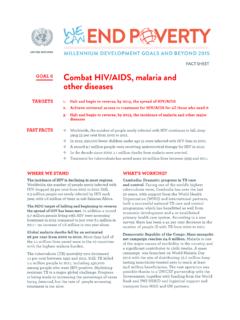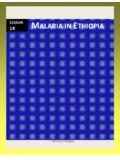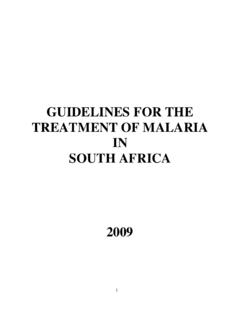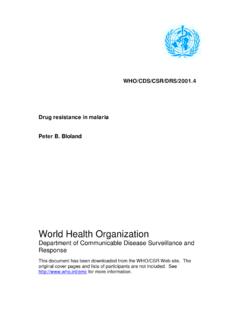Transcription of Mass drug administration, mass screening and …
1 malaria Policy Advisory Committee Meeting 16 18 September 2015, Geneva, Switzerland Background document for Session 1 This document was prepared as a pre-read for the meeting of the malaria Policy Advisory Committee and is not an official document of the World Health Organization. WHO/HTM/GMP/ mass drug administration , mass screening and treatment and focal screening and treatment for malaria WHO Evidence Review Group meeting report WHO Headquarters, Geneva 20 22 April 2015 Summary mass drug administration (MDA) has received renewed interest over the past decade in the context of malaria elimination, as part of multidrug resistance containment and (more recently) in emergency situations such as the West African Ebola outbreak.
2 To develop WHO recommendations, a group of experts met in April 2015 to review recent evidence on the use of MDA, mass screening and treatment (MSAT) and focal screening and treatment (FSAT) in specific epidemiological settings. The following recommendations were proposed by the WHO evidence review group, for consideration by the WHO malaria Policy Advisory Committee. Proposed recommendations 1. Use of MDA to interrupt transmission of falciparum malaria can be considered in endemic island communities and in low-endemic non-island settings approaching elimination, where there is minimal risk of re-introduction of infection, good access to treatment , and implementation of vector control and surveillance.
3 2. In view of the growing threat of multidrug resistance and the need to use extreme measures, MDA can be considered as a component of malaria elimination efforts in the Greater Mekong subregion, in areas with good access to treatment , vector control and good surveillance. 3. Use of MDA to rapidly reduce malaria morbidity and mortality can be consid ered for epidemic control as part of the immediate response, while other interventions are put in place. 4. Use of MDA to reduce malaria morbidity and mortality can be considered during exceptional circumstances, where the health system is overwhelmed and unable to serve the affected communities.
4 5. There is insufficient evidence to provide guidance on use of MDA in settings with moderate or high transmission; more research is required to inform future recommendations. 6. Using current diagnostic tests, MSAT and FSAT are not suitable as interventions to reduce malaria transmission. WHO Evidence Review Group meeting report, 20 22 April 2015 mass drug administration , mass screening and treatment and focal screening and treatment for malaria | 2 1 Background mass drug administration (MDA) refers to mass treatment of all, or a section of, the population, whether or not symptoms are present.
5 MDA has been implemented by national malaria control programmes (NMCPs) in the past as a way to control epidemics, or to reduce or interrupt transmission, and has generally been used in conjunction with indoor residual spraying (IRS). Based on a review of the results of 19 MDA projects during the period 1932 1999 (1), and a technical consultation held in 2003 (2), WHO concluded that there was little evidence that MDA is effective in reducing transmission, although in some cases a reduction in parasite prevalence and a transient reduction in mortality and morbidity were documented.
6 Therefore, WHO recommended mass treatment of symptomatic patients for epidemic and complex emergency situations, combined with an active search for febrile patients, to ensure that as many cases as possible are treated. Over the past decade, MDA has received renewed interest, both in the context of malaria elimination initiatives, and as part of efforts to contain multidrug resistance. In 2010, a WHO consultation reviewed the potential role of MDA to eliminate multidrug resistance in the Greater Mekong subregion (GMS), based on evidence of the impact of existing interventions, and operational and modelling considerations (3).
7 The consultation recommended immediate planning of a pilot MDA operation in western Cambodia or eastern Thailand, and the collection of essential information on the safety and efficacy of candidate drugs for MDA. The 2010 consultation also reviewed the potential role of mass screening and treatment (MSAT), in which all the people in a broad geographical area are screened, regardless of whether they have symptoms of malaria . MSAT generates important information on the epidemiology of malaria , which can be useful for further containment efforts. However, this approach is resource intensive and logistically challenging, especially in view of the lack of field-ready, high-throughput, diagnostic tests that are sensitive enough to detect submicroscopic parasites.
8 When applied in a defined geographical area (sometimes households), the strategy is defined as focal screening and treatment (FSAT), in which everyone is screened, and treatment is provided for those who test positive. FSAT is operationally more feasible than MSAT, but is not delivered simultaneously in the whole of an area sustaining malaria transmission; hence, it is unlikely to contribute significantly to elimination efforts. In 2010, WHO experts concluded that the contribution of MSAT and FSAT in reducing transmission needs to be confirmed (3). Abbreviations ACD active case detection LAMP loop-mediated isothermal amplification ACT artemisinin-based combination therapy LF lymphatic filariasis AE adverse event LLIN long-lasting insecticidal net AL artemether-lumefantrine MDA mass drug administration ASAQ artesunate-amodiaquine MPPT mass primaquine prophylactic treatment CHW community health worker MSAT mass screening and treatment CQ chloroquine MTAT mass test and treatment CRT cluster randomized trial NMCP national malaria control programme DBS dried blood spots nPCR nested PCR DHA-PPQ dihydroartemisinin-piperaquine NTD neglected
9 Tropical disease DOT directly observed therapy PCR polymerase chain reaction ERG evidence review group PQ primaquine FSAT focal screening and treatment PV pharmacovigilance G6PD glucose-6-phosphate dehydrogenase qPCR quantitative PCR GMP Global malaria Programme RACD reactive case detection GMS Greater Mekong subregion RDT rapid diagnostic test HRP2 histidine rich protein-2 SP sulfadoxine-pyrimethamine IRS indoor residual spraying TME targeted malaria elimination ITN insecticide-treated mosquito net WHO World Health Organization WHO Evidence Review Group meeting report, 20 22 April 2015 mass drug administration , mass screening and treatment and focal screening and treatment for malaria | 3 2 Overview Rationale A recent systematic review of MDA includes areas of different endemicity, various medicines and dosages, different timings and number of MDA rounds, and concomitant implementation of vector-control measures (4).
10 The review concluded that MDA appears to quickly reduce malaria parasitaemia and several clinical outcomes, but that more studies are required to assess the impact after 6 months, the barriers for community uptake and the potential contribution to the development of drug resistance. A subsequent review of 270 published and unpublished grey literature reports of MDA identified 48 MDA studies with follow-up periods of greater than 6 months, of which 12 showed zero indigenous malaria cases in the target population maintained over 6 months after the end of drug administration (5).

















